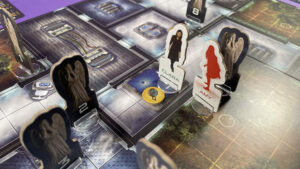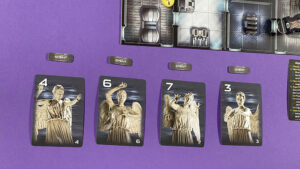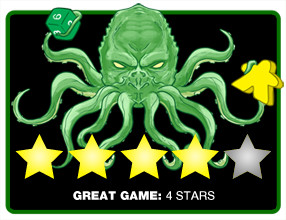As a board game enthusiast and a content creator for thebootdoctor.net, I’m always on the lookout for games that offer unique experiences and engaging themes. When I heard about Don’t Blink, a board game directly inspired by the terrifying Weeping Angels from Doctor Who, and specifically the iconic “don’t blink” episode, I knew I had to dive in. The Weeping Angels are, in my opinion, one of the most genuinely frightening monster concepts ever conceived for television. The idea that they can only move when you’re not looking, transforming into stone statues when observed, is pure genius and ripe for a tense and strategic game. Could this board game capture the chilling essence of those episodes and deliver a compelling tabletop experience? Let’s find out.
Gameplay Overview: Heroes vs. Angels in a Blink-and-You’ll-Miss-It Showdown
Don’t Blink is designed as a one-versus-many game, pitting one player as the Weeping Angels against up to four players taking on the roles of iconic Doctor Who heroes: the Doctor, Amy Pond, Rory Williams, and Clara Oswald. Each hero character comes with a unique special ability, adding a layer of asymmetry and strategic depth to the gameplay. The game board itself is modular, creating a labyrinthine 3×3 grid of locations, ensuring no two games feel exactly the same. Before the game begins, players decide their starting positions, setting the stage for a tense cat-and-mouse chase.
Each round is structured into five distinct phases:
- Choose Angels Phase: The Angel player secretly selects which of their Weeping Angel standees is the “real” Angel and chooses up to four Angel Identification cards to further mislead the heroes. This adds a crucial element of bluffing and psychological warfare to the Angel player’s strategy.
- Hero Move Phase: The heroes take their turns, each allowed to move up to six spaces, choose their facing direction (critical for line of sight), collect vital repair parts scattered across the board, and even strategically drag Angel standees around to disrupt the Angels’ plans. This phase is all about careful planning and coordination among the hero players.
 Don
Don
Alt Text: Doctor Who Don’t Blink board game hero movement phase illustrated with hero standees and the TARDIS game piece on the modular board.
- Hero Card Phase: Each hero must secretly assign a “Blink?” card to themselves for the upcoming Angel phase. These cards represent whether the hero is blinking or maintaining eye contact, a core mechanic mirroring the “don’t blink” nature of the Weeping Angels.
- Angel Phase: This is when the Weeping Angels activate! The Angel player moves their Angels up to nine spaces, attempts to catch the attention of heroes, and capture them. The crucial “Blink?” cards are revealed only when a Weeping Angel enters a hero’s line of sight. “Don’t Blink” cards revealed are discarded, making it statistically more likely for heroes to blink as the game progresses, increasing the tension and difficulty.
 Don
Don
Alt Text: Don’t Blink Doctor Who game showing Angel player checking hero’s Blink card during gameplay, illustrating the tension of line of sight and blinking mechanics.
The game continues until either the Heroes successfully return all the repair parts to the TARDIS (their victory condition) or the Angel player captures all the heroes, stealing their “lifetimes” (Angel victory).
Game Experience: Feeling the Terror from Both Sides
To truly understand Don’t Blink, I played both as a Hero and as the Angel, giving me a well-rounded perspective on the game’s strengths and nuances.
Playing as the Heroes: If you’re a fan of the “don’t blink” episodes of Doctor Who, you’ll instantly feel immersed in the game. The tension of trying to navigate the map, knowing the Weeping Angels could be lurking just out of sight, is palpable. The facing mechanic is brilliantly implemented, forcing you to constantly consider your line of sight and work strategically with your teammates. There’s a real sense of paranoia and urgency as you try to collect the repair parts while avoiding the gaze of the Angels.
One particularly interesting strategic element is the interplay between covered lines of sight and the limited “Don’t Blink” cards. There are moments where you might find yourself in a situation where all lines of sight seem covered, but you’re running low on “Don’t Blink” cards, creating a nail-biting gamble. Conversely, the Angel player’s ability to make sneak attacks, especially when a hero is isolated, is genuinely threatening. Sticking together as heroes is crucial for survival, but the parts are strategically placed across the map, forcing you to balance teamwork with the need to spread out and gather resources efficiently. This constant push and pull, this puzzle of finding the right approach, is what makes playing the Heroes so engaging and challenging.
 Don
Don
Alt Text: Doctor Who Don’t Blink board game action point tokens for the Angel player, highlighting the strategic choices available to control the Weeping Angels.
Playing as the Angels: While it might seem like the Angel player has an easy path to victory, deception and strategy are key. Choosing which Angels are “real” each round is a surprisingly complex decision. The “fake” Angels aren’t just static obstacles; they serve as decoys and psychological tools to mislead the heroes. Clever Angel players can use them to create traps and manipulate hero movement.
One challenge for the Angel player is managing the “frozen state”. If two “real” Angels are caught in each other’s line of sight, they become frozen, effectively removing them from play for a turn. Heroes can also exploit this by strategically dragging Angel standees to force a frozen state, rendering the Angel player’s turn useless. This creates a fascinating counter-dynamic where both sides are constantly trying to outmaneuver and out-think each other.
Regardless of which side you play, the initial setup and early game are filled with uncertainty. Heroes are cautiously moving towards objectives, while the Angel player is subtly positioning their pieces, creating a tense atmosphere right from the start. As the game progresses, the heroes’ limited movement speed contrasts with the Angels’ faster pace, leading to moments of frantic sprints and sudden standoffs. This ebb and flow can sometimes lead to a slightly slower pace, especially in the first few plays as players learn to anticipate each other’s strategies.
The strategic depth of Don’t Blink truly shines with fewer players, ideally around three. While the game technically supports up to five, higher player counts can sometimes lead to slower turns and potential “analysis paralysis.” However, with a group that communicates well and enjoys cooperative gameplay, even higher player counts can be enjoyable. I would recommend playing with a group familiar with each other’s playstyles for the best experience, especially for those new to one-versus-many games. The rulebook also offers variations and difficulty levels, promising replayability and opportunities to master both hero and angel roles.
Final Thoughts: A Tense and Thematic Doctor Who Experience
Don’t Blink is a well-designed board game that successfully captures the terrifying essence of the Weeping Angels and the “don’t blink” concept from Doctor Who. It offers a balanced and challenging experience for both heroes and the Angel player, filled with strategic puzzles and thematic immersion. If you enjoy tense, asymmetrical gameplay and appreciate the Doctor Who universe, particularly the Weeping Angels, then Don’t Blink is definitely worth checking out. However, be prepared for a game that requires strategic thinking and a willingness to engage in a mental battle of wits with your friends. If tactical gameplay and thematic immersion are your priorities, then you’ll find Don’t Blink to be a rewarding and replayable experience.
Final Score: 4 Stars – Dive into the world of Doctor Who and face the Weeping Angels in this thrilling one-versus-many game.
 4 Stars
4 Stars
Hits:
- Fun and engaging even for non-Doctor Who fans.
- Well-balanced roles offer distinct strategic challenges.
- Challenging and replayable, even as a 1v1 game.
Misses:
- Potential for “infighting” and slower turns with more hero players.
- The “real” vs. “fake” Angel mechanic can be slightly confusing initially.
- The initial setup and early game can feel a bit slow for some players.
